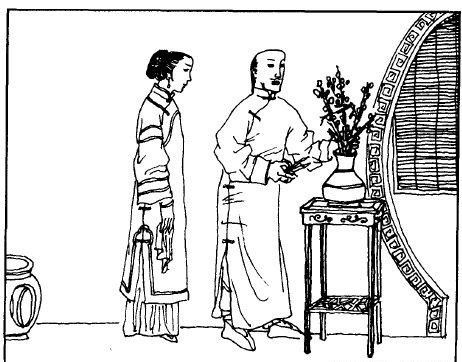Six Records of a Floating Life (Chapter two: Relaxation of Leisure 03)
In the case of flower bowls or open dishes, the method of making a support for the flowers is to mix pitch and refined resin with elm bark, flour and oil, and heat up the mixture with hot hay ashes until it becomes a kind of glue, and with it glue some nails upside down on to a piece of copper. This copper plate can then be heated up and glued on to the bottom of the bowl or dish.
When it is cold, tie the flowers in groups by means of wire and stick them on those nails. The flowers should be allowed to incline sideways and not shoot up from the centre; it is also important that the stems and leaves should not come too closely together. After this is done, put some water in the bowl and cover up the copper support with some clean sand, so that the flowers will seem to grow directly from the bottom of the bowl.
When picking branches from flower-trees for decoration in vases, it is important to know how to trim them before putting them in the vase, for one cannot always go and pick them oneself, and those picked by others are often unsatisfactory. Hold the branch in your hand and turn it back and forth in different ways in order to see how it lies most expressively.
After one has made up one's mind about it, lop off the superfluous branches, with the idea of making the twig look thin and sparse and quaintly beautiful. Next think how the stem is going to lie in the vase and with what kind of bend, so that when it is put there, the leaves and flowers can be shown to the best advantage.
If one just takes any old branch in hand, chooses a straight section and puts it in the vase, the consequence will be that the stem will be too stiff, the branches will be too close together and the flowers and leaves will be turned in the wrong direction, devoid of all charm and expression. To make a straight twig crooked, cut a mark half-way across the stem and insert a little piece of broken brick or stone at the joint; the straight branch will then become a bent one.
In case the stem is too weak, put one or two pins to strengthen it. By means of this method, even maple leaves and bamboo twigs or even ordinary grass and thistles will look very well for decoration. Put a twig of green bamboo side by side with a few berries of Chinese matrimony vine or arrange some fine blades of grass together with some branches of thistle. They will look quire poetic, if the arrangement is correct.
In planting new trees, it does not matter if the trunk comes up from the ground at an angle, for if let alone for a year, it will grow upwards by itself. On the other hand, if one lets the stem come up in a perpendicular line, it will be difficult later on for it to have a dynamic posture. As to the training of pot plants, one should choose those with claw-like roots coming above the surface of the ground. Lop off the first three branches from the ground before allowing the next one to grow up, making a bend at every point where a new branch starts off. There should be seven such bends, or perhaps nine, from the lower end of a tree to its top.
It is against good taste to have swollen joints at these bends, or to have two branches growing directly opposite each other at the same point. These must branch off in all directions from different points, for if one only allows those on the right and left to grow up, the effect will be very bare, or "the chest and back will be exposed," as we say.
Nor, for instance, should they grow straight from the front or behind. There are "double-trunked" and "treble-trunked "trees which all spring from the same root above the ground. If the root were not claw-shaped, they would look like planted sticks and would on that account be disqualified.
The proper training of a tree, however, takes at least thirty to forty years. In my whole life, I have seen only one person, old Wan Ts'aichang of my district, who succeeded in training several trees in his life. Once I also saw at the home of a merchant at Yangchow two pots, one of boxwood and one of cypress, presented to him by a friend from Yushan, but this was like casting pearls before swine.
Outside these cases, I have not seen any really good ones. Trees whose branches are trained in different horizontal circles going up like a pagoda or whose branches turn round and round like earthworms are incurably vulgar.




Comments
Post a Comment